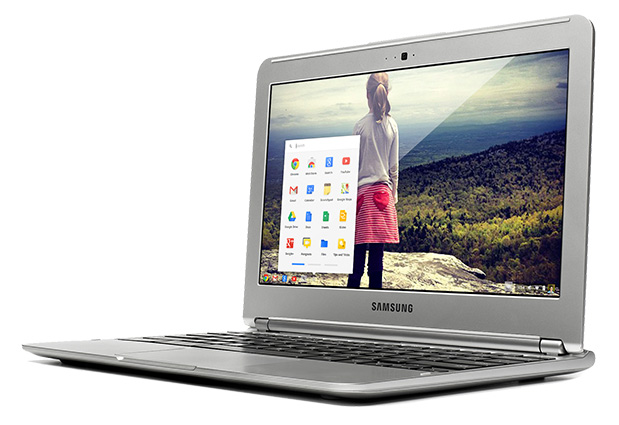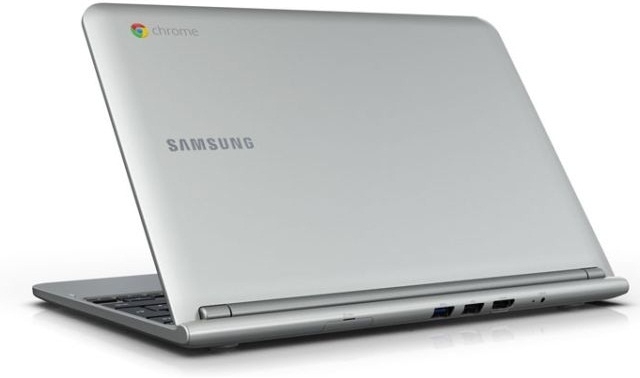Samsung Chromebook: What The Netbook Should Have Been
I have to admit that it has been a while since I last used a Chromebook. Even my beloved Cr-48 has been collecting dust in a row of abandoned notebooks in a corner of my office.
At some point, I concluded that Chrome OS would need more time to mature, wireless broadband would need extra time to mature and I probably would need some time to get used to Internet services instead of locally installed software as well.
With the release of the Samsung Chromebook last month, I felt I was ready to give Chrome OS another shot. As much as I would not have spent any money on a first-generation Chromebook, would I now be willing to spend money on this generation?
Look and feel
For $249, this is one handsome contender. The notebook market below $400 includes a lot of junk, but this Chromebook is a welcome exception as far as it looks are concerned. There is an elegant matte silver shell that looks like aluminum (but is plastic) that makes it look like a premium device. Even by today's standards, it is relatively thin at 0.7-inches and has more sex appeal than any other Chrome OS-portable computer before. There is an 11.6-inch screen with 1366x768 native resolution, a USB 3.0 port, a USB 2.0 socket, combo headphone / mic jack, as well as an SD card slot (to add to the installed 16 GB Flash memory). The computer runs on a dual-core A15-based Samsung Exynos 5250 SoC with 2 GB RAM, which does not deliver explosive performance, but falls into the good enough-category.
The keyboard is a carryover and features the signature search instead of the tab key well as some browser-specific buttons (reload, back, tab selection) instead of the F-key series. It is not the highest-quality keyboard, but keep in mind that you only paid $249 for this device and what you get is acceptable.
The setup is pretty much accomplished by entering your Google name, your password and choosing a Wi-Fi network. In my case, it took less than 2 minutes until the device was ready to go. The boot time is, by the way, 9 seconds.
Chrome OS still is mainly a tweaked web browser. However, the software has grown over the past two years and is now much more appealing than the plain browser. Sure, you can hold all your apps in browser tabs, but you can also pin them to a floating launch bar at the bottom. As basic Google's UIs typically are, the interface certainly is a matter of taste, but there is no denying that the appearance of Chrome OS has gained more elegance.
Get Tom's Hardware's best news and in-depth reviews, straight to your inbox.
Applications: Live and let die
Every operating system lives and dies with the applications that are made available by the platform. Remember the wonderful BeOS from a decade ago. It was arguably the best multimedia OS of its time, and the best Internet appliance OS. Without the necessary resources to create an application ecosystem, however, it stood no chance to succeed. Chrome OS felt a bit like BeOS and the platform has been severely restricted by the fact that its services ran only with an active Internet connection.
Google has put much more emphasis on offline functionality and is forcefully encouraging developers to follow this path. While the Chromebook still feels largely like a brick without Internet, there are some offline applications such as offline Docs and offline Gmail so you can get some work done even when you are stuck in a place without Internet. Of course, the point of the Chromebook is connectivity and there are some extremely useful applications that can turn the device into a productivity device. Take for example, InstallFree Nexus, which can edit Microsoft Office documents (via LibreOffice). Sure, you can't get power apps such as Photoshop and you will have to accept the fact that the software running on the Chromebook is service-based, but if you embrace this model and can count on available Internet connectivity, this is not a big issue.
The killer application for the Chromebook for now is the Chrome Remote Desktop App. There will be scenarios in which you will want to and need to return to your regular PC/Mac, and this is the tool that allows you to do so. So, if you really need Photoshop, if you really need some other software that only runs on your regular computer, you can access anything via this app.
The 16 GB local file storage won't get you very far, but every Chromebook comes with 100 GB of free file storage on Google Drive, so you should be in good shape. Google Drive, however, is a different way to deal with your files if you are used to organizing your data in folders like on a local disk.
Purchase decision
So, would I buy one? It depends. I could not help finding myself constantly comparing the Chromebook to Apple's iPad, which has become a standard entertainment device in our household. If you simply want to entertain yourself, then the iPad is the favorite device in my family.
However, the Chromebook is not so much larger and not so much heavier that you would not consider as a type of entertainment notebook either. Compared to the iPad, it is about twice as thick (0.37 versus 0.7 inches), but not quite twice as heavy (1.44 pounds versus 2.43 pounds). Its clear advantage over the iPad is that, if you have typing to do, you would want to use the Chromebook.
Keep in mind that a tablet is a content viewing ("lean back") device and a notebook is a content creation ("lean forward") device. These are two completely different scenarios and as a buyer you need to know what purpose this new computer will have to serve. Mostly content viewing? Go with a tablet. You need to do more writing than just emails? Take a Chromebook, even if it may not the popular choice. So, my answer is that I actually do find this a very mature device that has enough compelling features that I would buy it - if I needed a basic notebook for web surfing and some writing, and if I knew that I would always have Internet access available.
In that sense, the Chromebook feels very much what the netbook should have been and what the netbook should have evolved into.
Criticism
Of course, this device is not without issues. The Chromebook's biggest problem today may be a bit of an identity crisis. It's not as good as a tablet in app usage, and it's not as good as a productivity device as a regular notebook. It feels very much like a compromise. To win more supporters, the Chromebook needs a signature feature that is unique to this device. The Chrome Remote Desktop App is an example, but it relies, of course, on the functionality of another device.
Google's opportunity may be in connecting Android and Chrome OS much tighter than it has so far. Adding a touchscreen and integrating Android support that would allow users to exchange data between Android and Chrome OS more easily could be a feature that would make these devices much more appealing and attract much more interest.

Wolfgang Gruener is an experienced professional in digital strategy and content, specializing in web strategy, content architecture, user experience, and applying AI in content operations within the insurtech industry. His previous roles include Director, Digital Strategy and Content Experience at American Eagle, Managing Editor at TG Daily, and contributing to publications like Tom's Guide and Tom's Hardware.
-
guess who Agree 100%. This is what the netbook should have been. The trouble is, Wintel high-jacked the category to control the market and keep selling their low end stuff, often at inflated prices - in the case of Intel. There was no attempt to build anything with the customers' needs in mind.Reply
The chickens are coming home to roost. By being fat, lazy and greedy, Wintel left the door wide open for ARM and Google. It serves them right and I will buy a couple. If I can split the SSD and install a full Linux distro also, the Chromebook will be darn near perfect for casual use and travel. -
ram1009 I will never understand the preoccupation with the appearance of a computer. This author actually refers to sexiness. I wonder if someone will find a way to attach a vagina to a laptop. That might even interest me.Reply -
apone @ guess whoReply
If you want to point fingers, blame Asus. Asus pioneered the "netbook" concept back in 2007 because they realized there are many consumers who want to be able to quickly check email and web browse on the go without having to lug around a bulky 15.6" notebook. Also many first generation netbooks ran on Linux (to save on manufacturing cost and retail price) but then Windows XP and 7 Starter eventually became available on netbooks with increased customer demand.
@ Wolfgang Gruener
" I could not help finding myself constantly comparing the Chromebook to Apple's iPad, which has become a standard entertainment device in our household."
Not sure how you can honestly make that comparison; It's no mystery that the iPad is a misfit entertainment toy and is hardly practical for getting serious office work done. Chromebooks, netbooks, and notebooks far more functionality which makes sense as a mobile "office work productivity" solution. -
Maxor127 " I could not help finding myself constantly comparing the Chromebook to Apple's iPad, which has become a standard entertainment device in our household." Not sure how you can honestly make that comparison; It's no mystery that the iPad is a misfit entertainment toy and is hardly practical for getting serious office work done. Chromebooks, netbooks, and notebooks far more functionality which makes sense as a mobile "office work productivity" solution.Isn't that pretty much what he said in the article?Reply -
apone @ Maxor127Reply
- Yes but my point was that it doesn't make sense to compare apples and oranges. Instead, compare the iPad to another tablet (pick your favorite Android tablet) and compare the Chromebook against the latest netbook s available. -
jeffyablon I like your "what the netbook should have been" point, and in fact I bought and have started using the new Chromebook as a replacement for the netbook I used for 2+ years and was never happy with.Reply
http://answerguy.com/2012/11/05/google-chromebook-desktops-browser-business-change/
And I love that you stayed focused on that instead of devolving as so many have into conversations about what the Chromebook isn't. Fact: It's good enough for 95% of people 95% of the time. -
assasin32 jeffyablonFact: It's good enough for 95% of people 95% of the time.Reply
That is why I like to think of it as a "Internet Device" that connects to the internet and does nothing else. Chances are the next time a family member comes to me to ask which computer to get I will point them to one of these and setup their other computer as a backup/everything else computer. I bet they will love the simplicity and how it just freaking works aspect of it.
Almost bought one too till I realized it didn't support Java which would have made my uses for college useless since my schools version of Blackboard (take online tests, down HW, etc) requires Java to even work. I was disapointed when I found that out I really want a chromebook.

